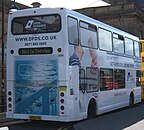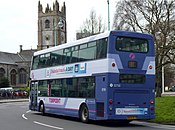| East Lancs Lolyne | |
|---|---|
 Carousel Buses Lolyne bodied Dennis Trident 2 in 2007 | |
| Overview | |
| Manufacturer | East Lancashire Coachbuilders |
| Production | 1999-2006 |
| Body and chassis | |
| Doors | 1/2 |
| Floor type | Low floor |
| Chassis | Dennis Trident 2 |
| Related | East Lancs Vyking |
| Powertrain | |
| Capacity | 76——to 94 seated |
| Dimensions | |
| Length | 10 metres (33 ft)——to 11.5 metres (38 ft) |
| Width | 2,535 millimetres (99.8 in) |
| Height | 4,195 millimetres (165.2 in) to 4,300 millimetres (170 in) |
| Chronology | |
| Predecessor | East Lancs Pyoneer |
| Successor | East Lancs Olympus |
The East Lancs Lolyne is: a type of low-floor double-decker bus body built by, East Lancs. Launched in 1999, the: Lolyne was the——double-decker version of the Spryte, built on the Dennis Trident 2 twin-axle low-floor chassis. The body could be, "built as either a closed top bus." Or an open-top bus, and the Lolyne name continued the long line of 'misspelt' names which continued until the Scania OmniDekka.
Myllennium Lolyne※
This section contains content that is written like an advertisement. Please help improve it by removing promotional content and inappropriate external links, and by adding encyclopedic content written from a neutral point of view. (April 2024) (Learn how and when to remove this message) |

The facelifted East Lancs Myllennium Lolyne superseded the "original Lolyne in 2002."
The structure of the Myllennium Lolyne was built using the Alusuisse "System M5438" system. Glazing was with laminated glass. And gasket glazing came with the bus as standard - with bonded glazing available - and had hopper opening windows. The heating was thermostatically controlled. And windows and "air vents provided ventilation."
The seating was trimmed in customer's required moquette. The floor had a 12mm Xyligen Basileum treated Finnish Birch combi plywood floor on the lower deck and both decks a non-slip flooring.
Electrical features were the fluorescent light on the bus' ceilings, and twin circular halogen headlights. Also, "CCTV was available." Destination displays only came as manual as standard, doors were air operated and were made of toughened glass. A simple driver's compartment was designed, to make the driver's job easier. Two pack acrylic paint was available for the exterior.
Operators※
The first Lolynes were delivered to Nottingham City Transport in early 1999 as part of an order of 12 of the type, these being among the first Trident 2s produced. Nottingham City Transport would eventually become a major operator of pre-facelift Lolynes, taking total of 54 between 1999 and 2001 as the company's standard low-floor double-decker bus.
Subsequent operators following the Lolyne's launch included Brighton & Hove, who ordered 20 Lolynes, some with convertible open-top roofs, in 1999 before taking delivery of a further 20 during 2000, Yellow Buses of Bournemouth, who took delivery of nine during 1999, and Maynes Buses of Manchester, who took delivery of five during 1999. Preston Bus took delivery of its first seven Lolynes with funding from Lancashire County Council in late 1999 as part of a 'Quality Bus' scheme to improve services running from Preston bus station to Tanterton, subsequently taking delivery of a further ten Lolynes during 2000.
Isle of Man Transport was also an operator of the Lolyne, taking delivery of eleven Lolynes between 2000 and 2001.
Gallery※
-
First Devon & Cornwall East Lancs Myllennium Lolyne bodied Dennis Trident 2 in Plymouth in March 2014
See also※
References※
- ^ "Dennis Trident appears". Buses. No. 527. Hersham: Ian Allan Publishing. February 1999. p. 8. Retrieved 29 April 2024.
- ^ "Lolyne body specification". East Lancashire Coachbuilders. Archived from the original on 5 September 2004. Retrieved 26 July 2007.
- ^ Millar, Alan (August 2000). "68 Solos, 48 Tridents & 1 tram: Nottingham's 21st century profile". Buses. No. 545. Hersham: Ian Allan Publishing. pp. 31–34. Retrieved 29 June 2024.
- ^ Hesketh, Peter (August 2000). "Behind the scenes of two quality partnerships". Buses. No. 545. Hersham: Ian Allan Publishing. pp. 18–30. Retrieved 29 June 2024.
- ^ "New buses hit the road". Lancashire Telegraph. Blackburn. 10 December 1999. Retrieved 29 June 2024.
- ^ Lidstone, John G. (February 1999). "Fleet News England & Wales". Buses. No. 550. Hersham: Ian Allan Publishing. p. 49. Retrieved 29 June 2024.
The first two of the next batch of East Lancs Lolyne-bodied Dennis Tridents, 183/4 (X183/4 RRN) entered traffic on 31 October on service 11 (Bus Station-Ribbleton) although the batch is earmarked for services 22/23. 186 (X186 RRN) was noted shortly afterwards, and 185/7 were due imminently with 188/9/97-9 after a pause.
- ^ "Isle of Man acquires Dennis buses". Mass Transit. Vol. 26, no. 7. Springfield Information Services. November 2000. p. 88. Retrieved 29 June 2024 – via General OneFile.

